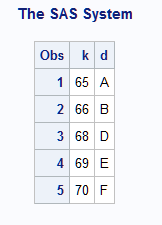REMOVE Method
Removes the data that is associated with the specified
key from the hash object.
| Applies to: | Hash object |
Syntax
Arguments
- KEY: keyvalue
-
specifies the key value whose type must match the corresponding key variable that is specified in a DEFINEKEY method callThe number of “KEY: keyvalue” pairs depends on the number of key variables that you define by using the DEFINEKEY method.Restriction:If an associated hash iterator is pointing to the keyvalue, then the REMOVE method will not remove the key or data from the hash object. An error message is issued.
Details
You can specify the
key, and then use the REMOVE method as shown in the following code:
data _null_;
length k $8;
length d $12;
if _N_ = 1 then do;
declare hash h();
rc = h.defineKey('k');
rc = h.defineData('d');
rc = h.defineDone();
/* avoid uninitialized variable notes */
call missing(k, d);
end;
rc = h.add(key: 'Joyce', data: 'Ulysses');
/* Specify the key */
k = 'Joyce';
/* Use the REMOVE method to remove the key and data */
rc = h.remove();
if (rc = 0) then
put 'Key and data removed from the hash object.';
run;Alternatively, you can
use a shortcut and specify the key directly in the REMOVE method call
as shown in the following code:
data _null_;
length k $8;
length d $12;
if _N_ = 1 then do;
declare hash h();
rc = h.defineKey('k');
rc = h.defineData('d');
rc = h.defineDone();
/* avoid uninitialized variable notes */
call missing(k, d);
end;
rc = h.add(key: 'Joyce', data: 'Ulysses');
rc = h.add(key: 'Homer', data: 'Iliad');
/* Specify the key in the REMOVE method parameter */
rc = h.remove(key: 'Homer');
if (rc =0) then
put 'Key and data removed from the hash object.';
run;Example: Removing a Key in the Hash Table
This example illustrates
how to remove a key in the hash table.
/* Generate test data */
data x;
do k = 65 to 70;
d = byte (k);
output;
end;
run;
data _null_;
length k 8 d $1;
/* define the hash table and iterator */
declare hash H (dataset:'x', ordered:'a');
H.defineKey ('k');
H.defineData ('k', 'd');
H.defineDone ();
call missing (k,d);
declare hiter HI ('H');
/* Use this logic to remove a key in the hash table
when an iterator is pointing to that key */
do while (hi.next() = 0);
if flag then rc=h.remove(key:key);
if d = 'C' then do;
key=k;
flag=1;
end;
end;
rc = h.output(dataset: 'work.out');
stop;
run;
proc print;
run;See Also
Replacing and Removing Data in the Hash Object in SAS Language Reference: Concepts
